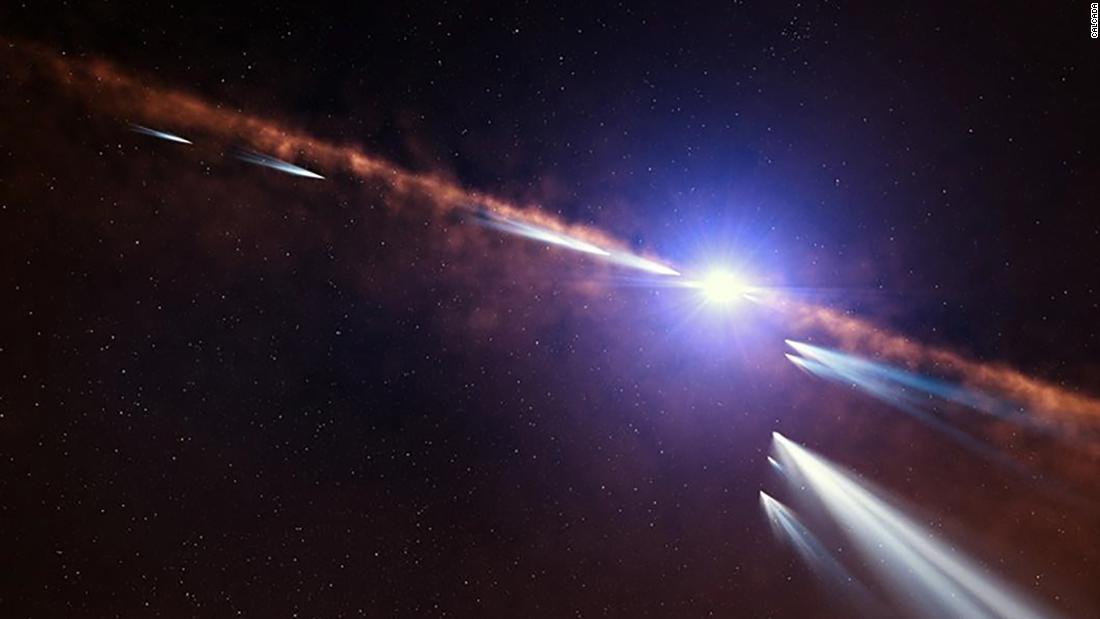
Now, astronomers have found 30 exocomets, or comets located outside of our solar system, orbiting the sunlike Beta Pictoris star, which makes it even more intriguing.
The Beta Pictoris star was discovered nearly 40 years ago. It is surrounded by a debris disk made of gas and dust, which has already birthed two young planets that orbit the star. It offers researchers a rare chance to watch a planetary system that’s in the process of forming. While our solar system is 4.5 billion years old, Beta Pictoris is only 20 million years old — which is young, astronomically speaking.
Scientists were able to detect a few comets grazing by the star as early as 1987, making them the first comets ever observed around a star besides our sun.
An international research team observed the Beta Pictoris system for 156 days using NASA’s Transiting Exoplanet Survey Satellite, or TESS, mission.
In addition to discovering 30 exocomets, the researchers also were able to determine the size of the cometary nuclei — the icy “dirty snowball” that makes up the heart of a comet. When comets pass close to a star, the heat of the star causes their ice to sublimate, creating long, streaming tails that can stretch behind the comets.
The nuclei of the exocomets range between 1.8 and 8.7 miles (3 and 14 kilometers) in diameter, similar to comets in our own solar system. This is the first time astronomers have measured the size distribution of comets in another planetary system.
In Beta Pictoris, comets “graze the star almost every day,” said lead study author Alain Lecavelier des Etangs, CNRS researcher at the Institut d’Astrophysique de Paris, in a statement.
Much like the comets astronomers study in our solar system, the exocomets were shaped by collisions with other objects.
“This shows the importance of the interactions, collisions, exchange of material between planets and small bodies such as asteroids or comets in the early stage of a planetary system life,” Lecavelier des Etangs said.
Some of the water on Earth likely originated from comets and their ice content, so scientists are curious to learn how comets may have impacted exoplanets as well.
“We cannot assure that the observed comets are likely to deliver material like water to planets orbiting Beta Pictoris, but our observations show that collisions are very common and therefore suggests that temperate planets can be enriched in material trapped in frozen ices captured by the comets when (the comets) are far from the star and later collide with the planets,” he said.
While there are many similarities between Beta Pictoris’ exocomets and our solar system’s comets, just exactly how similar and different they are “remains to be determined,” Lecavelier des Etangs said.
The exocomets can help shed light on the origin and evolution of comets in general, and future observations of the planetary system using Hubble and the James Webb Space Telescope could reveal more details about them.
“The question of the composition of these comets remains open,” he said.
The researchers want to determine what substance sublimates, or turns from a solid to a gas, as the exocomets approach the Beta Pictoris star. It could be water ice, carbon monoxide or something else entirely.
The system has the unique combination of three factors that keep astronomers coming back: It’s young, nearby and telescopes have the perfect perspective of it from Earth.
“Nature provided us with such an amazing target,” Lecavelier des Etangs said. “Many questions remain open. I am sure that Beta Pictoris will keep us busy for the next decades!”